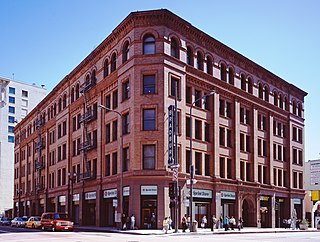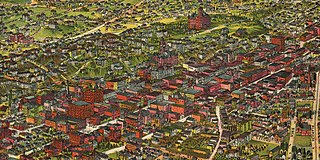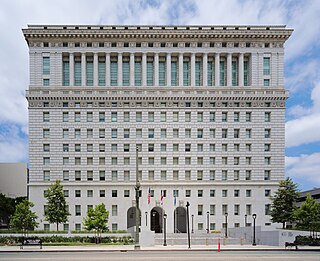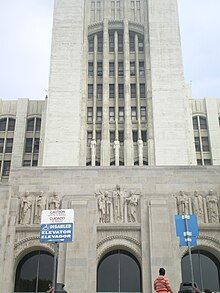
The Ambassador Hotel was a hotel in Los Angeles, California. Designed by architect Myron Hunt, the Ambassador Hotel formally opened to the public on January 1, 1921. Later renovations by architect Paul Williams were made to the hotel in the late 1940s. It was also home to the Cocoanut Grove nightclub, a premier Los Angeles night spot for decades; host to six Oscar ceremonies and to every United States President from Herbert Hoover to Richard Nixon.

The Bradbury Building is an architectural landmark in downtown Los Angeles, California, United States. Built in 1893, the five-story office building is best known for its extraordinary skylit atrium of access walkways, stairs and elevators, and their ornate ironwork. The building was commissioned by Los Angeles gold-mining millionaire Lewis L. Bradbury and constructed by architect George Wyman from the original design by Sumner Hunt. It appears in numerous works of fiction and has been the site of many movie and television shoots and music videos.

The Civic Center neighborhood of Los Angeles, California, is the administrative core of the City of Los Angeles, County of Los Angeles, and a complex of city, county, state, and federal government offices, buildings, and courthouses. It is located on the site of the former business district of the city during the 1880s and 1890s, since mostly-demolished.

Broadway, until 1890 Fort Street, is a thoroughfare in Los Angeles County, California, United States. The portion of Broadway from 3rd to 9th streets, in the Historic Core of Downtown Los Angeles, was the city's main commercial street from the 1910s until World War II, and is the location of the Broadway Theater and Commercial District, the first and largest historic theater district listed on the National Register of Historic Places (NRHP). With twelve movie palaces located along a six-block stretch of Broadway, it is the only large concentration of movie palaces left in the United States.

George Edwin Bergstrom was an American architect who designed many buildings in Los Angeles, California and The Pentagon in Arlington County, Virginia.
The Jefferson Barracks Military Post is located on the Mississippi River at Lemay, Missouri, south of St. Louis. It was an important and active U.S. Army installation from 1826 through 1946. It is the oldest operating U.S. military installation west of the Mississippi River, and it is now used as a base for the Army and Air National Guard. A Veterans Affairs healthcare system campus is located on the southern portion of the base and is also the headquarters for the Veterans Canteen Service.

Sumner P. Hunt was an architect in Los Angeles from 1888 to the 1930s. On January 21, 1892, he married Mary Hancock Chapman, January 21, 1892. They had a daughter Louise Hunt.

The Los Angeles National Cemetery is a United States National Cemetery in the Sawtelle unincorporated community of the West Los Angeles neighborhood in Los Angeles County, California.
Edwin Wallace Neff was an architect based in Southern California and was largely responsible for developing the region's distinct architectural style referred to as "California" style. Neff was a student of architect Ralph Adams Cram and drew heavily from the architectural styles of both Spain and the Mediterranean as a whole, gaining extensive recognition from the number of celebrity commissions, notably Pickfair, the mansion belonging originally to Mary Pickford and Douglas Fairbanks.
Edward Hale Fickett, FAIA, was an American architect who was a consultant to federal and local governments in the United States and to President Dwight D. Eisenhower.

John Corneby Wilson Austin was an architect and civic leader who participated in the design of several landmark buildings in Southern California, including the Griffith Observatory, Los Angeles City Hall, and the Shrine Auditorium.

The Sawtelle Veterans Home was a care home for disabled American veterans in what is today part of the Los Angeles metropolitan area in California in the United States. The Home, formally the Pacific Branch of the National Home for Disabled Volunteer Soldiers, was established in 1887 on 300 acres (1.2 km2) of Rancho San Vicente y Santa Monica lands donated by Senator John P. Jones and Arcadia B. de Baker. The following year, the site grew by an additional 200 acres (0.81 km2); in 1890, 20 acres (0.081 km2) more were appended for use as a veterans' cemetery. With more than 1,000 veterans in residence, a new hospital was erected in 1900. This hospital was replaced in 1927 by the James W. Wadsworth Hospital, now known as the West Los Angeles VA Medical Center.

Historic South Central Los Angeles is a 2.25-square-mile neighborhood in Los Angeles, California, within the South Los Angeles region. It is the site of the Bob Hope Patriotic Hall.

Bob Hope Patriotic Hall is a 10-story building that was dedicated as Patriotic Hall by the Los Angeles Board of Supervisors in 1925 and was built to serve veterans of Indian Wars, Spanish–American War, World War I and to support the Grand Army of the Republic. It serves as the home of the Los Angeles County Department of Military and Veterans Affairs. Patriotic hall was rededicated to honor of Bob Hope and renamed "Bob Hope Patriotic Hall" on November 12, 2004.
Silas Reese Burns (1855–1940) was an American architect.

The late-Victorian-era Downtown of Los Angeles in 1880 was centered at the southern end of the Los Angeles Plaza area, and over the next two decades, it extended south and west along Main Street, Spring Street, and Broadway towards Third Street. Most of the 19th-century buildings no longer exist, surviving only in the Plaza area or south of Second Street. The rest were demolished to make way for the Civic Center district with City Hall, numerous courthouses, and other municipal, county, state and federal buildings, and Times Mirror Square. This article covers that area, between the Plaza, 3rd St., Los Angeles St., and Broadway, during the period 1880 through the period of demolition (1920s–1950s).

The Hall of Justice in Los Angeles is located at 211 W. Temple Street in the Civic Center district of Downtown Los Angeles. It occupies the southern two-thirds of the block between Temple and First streets and between Broadway and Spring streets.

Davis & Davis was an architecture firm in Los Angeles, California made up of brothers F. Pierpont and Walter S. Davis.
















